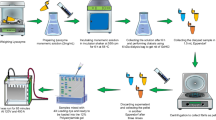Abstract
The mechanism(s) by which zinc is transported into cells has not been identified. Since zinc uptake is inhibited by reducing the temperature, zinc uptake may depend on the movement of plasma membrane micoenvironments, such as endocytosis or potocytosis. We investigated the potential role of potocytosis in cellular zinc uptake by incubating normal and acrodermatitis enteropathica fibroblasts with nystatin, a sterol-binding drug previously shown to inhibit potocytosis. Zinc uptake was determined during initial rates of uptake (10 min) following incubation of the fibroblasts in 50 μg nystatin/mL or 0.1% dimethyl-sulfoxide for 10 min at 37°C. The cells were then incubated with 1 to 30 μM 65zinc. Michaelis-Menten kinetics were observed for zinc uptake. Nystatin inhibited zinc uptake in both the normal and AE fibroblasts. Reduced cellular uptake of zinc was associated with its internalization, not its external binding. In normal fibroblasts, nystatin significantly reduced theK m 56% and theV max 69%. In the AE fibroblasts, nystatin treatment significantly reduced theV max 59%, but did not significantly affect theK m. The AE mutation alone affected theV max for cellular zinc uptake. The control AE fibroblasts exhibited a 40% reduction inV max compared to control normal fibroblasts. We conclude that nystatin exerts its effect on zinc uptake by reducing the velocity at which zinc traverses the cell membrane, possibly through potocytosis. Furthermore, the AE mutation also effects zinc transport by reducing zinc transport.
Similar content being viewed by others
References
M. L. Failla and R. J. C. Cousins, Zinc uptake by Isolated rat liver parenchymal cells.Biochim. Biophys. Acta 538, 435–444 (1978).
M. Statter and I. Krieger, Zinc transport in human fibroblasts: Kinetics and effects of ligands,Pediat. Res. 17, 239–240 (1983).
M. L. Ackland, D. M. Danks, and H. J. McArdle. Studies on the mechanism of zinc uptake by human fibroblasts,J. Cell. Physiol. 135, 521–526 (1988).
M. L. Ackland and H. J. McArdle. Significance of extracellular zinc-binding ligands in the uptake of zinc by human fibroblasts,J. Cell. Physiol 145, 409–413 (1990).
M. P. Menard and R. J. C. Cousins, Zinc transport by brush border membrane vesicles from rat intestine,J. Nutr. 113, 1434–1442 (1983).
P. Blakeborough and D. N. Salter, The intestinal transport of zinc studied using brush border membrane vesicles from the piglet,Br. J. Nutr. 57, 45–55 (1987).
F. Tacnet, D. W. Watkins, and P. Ripoche, Studies of zinc transport into brush border membrane vesicles isolated from pig small intestine,Biochim. Biophys. Acta 1024, 323–330 (1990).
F. Tacnet, F. Lauthier, and P. Ripoche. Mechanisms of zinc transport into pig small intestine brush border membrane vesicles,J. Physiol. 465, 57–72 (1993).
D. J. Bobilya, M. Briske-Anderson, and P. G. Reeves, Zinc transport into endothelial cells is a facilitated process,J. Cell. Physiol. 151, 1–7 (1992).
K. G. Rothberg, Y. Ying, J. F. Kolhouse, B. A. Kamen, and R. G. W. Anderson, The glycophospholipid-linked folate receptor internalizes folate without entering the clathrin-coated pit endocytic pathway.J. Cell Biol. 110, 637–649 (1990).
K. G. Rothberg, J. E. Heuser, W. C. Donzell, Y. Ying, J. R. Glenney, and R. G. W. Anderson, Caveolin, a protein component of caveolae membrane coats,Cell 68, 673–682 (1992).
R. G. W. Anderson, B. A. Kamen, K. G. Rothberg, and S. W. Lacey, Potocytosis: Sequestration and transport of small molecules by caveolae.Science 255, 410–411 (1990).
K. G. Rothberg, Y. Ying, B. A. Kamen, and R. G. W. Anderson, Cholesterol controls the clustering of the glycophospholipid-anchored membrane receptor for 5-methyltetrahydrofolate,J. Cell Biol. 111, 2931–2938 (1990).
D. A. Young, R. O. Deems, R. W. Deacon, R. H. McIntosh, and J. E. Foley, Effects of amylin on glucose metabolism and glycogenolysis in vivo and in vitro,Am. J. Physiol. 259, E457-E461 (1990).
F. Vazquez and A. Grider, The effect of the acrodermatitis enteropathica mutation on zinc uptake in human fibroblasts,Biol. Trace Element Res. 50, 109–118 (1995).
E. Jawetz, Antifungal agents, inBasic and Clinical Pharmacology, 5th ed., B. G. Katzung, ed., Appleton and Lange, Norwalk, CT., pp. 667–673 (1992).
M. Dixon and E. C. Webb, Enzyme inhibition and activation, inEnzymes, 3rd ed., M. Dixon and E. C. Webb, eds., Academic, New York, pp. 332–467 (1979).
Author information
Authors and Affiliations
Rights and permissions
About this article
Cite this article
Grider, A., Vazquez, F. Nystatin affects zinc uptake in human fibroblasts. Biol Trace Elem Res 54, 97–104 (1996). https://doi.org/10.1007/BF02786256
Received:
Accepted:
Issue Date:
DOI: https://doi.org/10.1007/BF02786256




